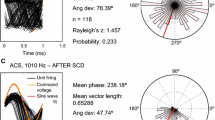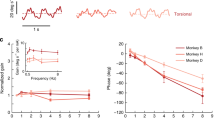Abstract
In mammals, vestibular-nerve afferents that innervate only type I hair cells (calyx-only afferents) respond nearly in phase with head acceleration for high-frequency motion, whereas afferents that innervate both type I and type II (dimorphic) or only type II (bouton-only) hair cells respond more in phase with head velocity. Afferents that exhibit irregular background discharge rates have a larger phase lead re-head velocity than those that fire more regularly. The goal of this study was to investigate the cause of the variation in phase lead between regular and irregular afferents at high-frequency head rotations. Under the assumption that externally applied galvanic currents act directly on the nerve, we derived a transfer function describing the dynamics of a semicircular canal and its hair cells through comparison of responses to sinusoidally modulated head velocity and currents. Responses of all afferents were fit well with a transfer function with one zero (lead term). Best-fit lead terms describing responses to current for each group of afferents were similar to the lead term describing responses to head velocity for regular afferents (0.006 s + 1). This finding indicated that the pre-synaptic and synaptic inputs to regular afferents were likely to be pure velocity transducers. However, the variation in phase lead between regular and irregular afferents could not be explained solely by the ratio of type I to II hair cells (Baird et al 1988), suggesting that the variation was caused by a combination of pre- (type of hair cell) and post-synaptic properties.



Similar content being viewed by others
References
Anderson JH, Blanks RHI, Precht W (1978) Response characteristics of semicircular canal and otolith systems in cat. I. Dynamic responses of primary vestibular nerve fibers. Exp Brain Res 32:491–507
Aw ST, Todd MJ, Aw GE, Weber KP, Halmagyi GM (2008) Gentamicin vestibulotoxicity impairs human electrically evoked vestibulo-ocular reflex. Neurology 71:1776–1782
Aw ST, Todd MJ, Lehnen N, Aw GE, Weber KP, Eggert T, Halmagyi GM (2010) Does the human electrically-evoked vestibulo-ocular reflex rely on vestibular hair cell transduction? J Vest Res 20:166
Baird RA, Desmadryl G, Fernández C, Goldberg JM (1988) The vestibular nerve of the chinchilla. II. Relation between afferent response properties and peripheral innervation patterns in the semicircular canals. J Neurophysiol 60:182–203
Blanks RH, Precht W (1976) Functional characterization of primary vestibular afferents in the frog. Exp Brain Res 25:369–390
Boyle R, Highstein SM (1990) Resting discharge and response dynamics of horizontal semicircular canal afferents of the toadfish, Opsanus tau. J Neurosci 10:1557–1569
Brichta AM, Goldberg JM (1998) The papilla neglecta of turtles: a detector of head rotations with unique sensory coding properties. J Neurosci 18:4314–4324
Fernández C, Baird RA, Goldberg JM (1988) The vestibular nerve of the chinchilla. I. Peripheral innervation patterns in the horizontal and superior semicircular canals. J Neurophysiol 60:167–181
Goldberg JM, Fernández C (1971) Physiology of peripheral neurons innervating semicircular canals of the squirrel monkey I. Resting discharge and response to constant angular accelerations. J Neurophysiol 34:635–660
Goldberg JM, Smith CE, Fernández C (1984) Relation between discharge regularity and responses to externally applied galvanic currents in vestibular nerve afferents of the squirrel monkey. J Neurophysiol 51:1236–1256
Goldberg JM, Lysakowski A, Fernández C (1990) Morphophysiological and ultrastructural studies in the mammalian cristae ampullares. Hear Res 49:89–102
Guth PS, Perin P, Norris CH, Valli P (1998) The vestibular hair cells: post-transductional signal processing. Prog Neurobiol 54:193–247
Highstein SM, Baker R (1985) Action of the efferent vestibular system on primary afferents in the toadfish, Opsanus tau. J Neurophysiol 54:370–384
Highstein SM, Rabbitt RD, Boyle R (1996) Determinants of semicircular canal afferent response dynamics in the toadfish, Opsanus tau. J Neurophysiol 75:575–596
Hirvonen TP, Minor LB, Hullar TE, Carey JP (2005) Effects of intratympanic gentamicin on vestibular afferents and hair cells in the chinchilla. J Neurophysiol 93:643–655
Holstein GR, Rabbitt RD, Martinelli GP, Friedrich VL Jr, Boyle RD, Highstein SM (2004) Convergence of excitatory and inhibitory hair cell transmitters shapes vestibular afferent responses. Proc Natl Acad Sci U S A 101:15766–15771
Hullar TE, Della Santina CC, Hirvonen TP, Lasker DM, Carey JP, Minor LB (2005) Responses of irregularly discharging chinchilla semicircular canal vestibular-nerve afferents during high-frequency head rotations. J Neurophysiol 93:2777–2786
Kalluri R, Xue J, Eatock RA (2010) Ion channels set spike timing regularity of mammalian vestibular nerve afferents. J Neurophysiol 104:2034–2051
Lasker DM, Han GC, Park HJ, Minor LB (2008) Rotational responses of vestibular-nerve afferents innervating the semicircular canals in the C57BL/6 mouse. J Assoc Res Otolaryngol 9:334–348
Lasker DM, Kim KS, Park HJ, Carey JP, Minor LB (2009) The effect of CNQX on single unit responses of horizontal canal afferents in the chinchilla. ARO MidWinter meeting abstract 1128
Li W, Correia MJ (1998) Recovery of semicircular canal primary afferent activity in the pigeon after streptomycin ototoxicity. J Neurophysiol 80:3297–3311
Park HJ, Lasker DM, Minor LB (2010) Static and dynamic discharge properties of vestibular-nerve afferents in the mouse are affected by core body temperature. Exp Brain Res 200:269–275
Risner JR, Holt JR (2006) Heterogenous potassium conductances contribute to the diverse firing properties of postnatal mouse vestibular ganglion neurons. J Neurophysiol 96:2364–2376
Sadeghi SG, Minor LB, Cullen KE (2007) Response of vestibular-nerve afferents to active and passive rotations under normal conditions and after unilateral labyrinthectomy. J Neurophysiol 97:1503–1514
Smith CE, Goldberg JM (1986) A stochastic afterhyperpolarization model of repetitive activity in vestibular afferents. Biol Cybern 54:41–51
Steinhausen W (1933) Ueber die Beobachtung der Cupula in den Bogengangsampullen des Labyrinths des lebenden Hechts. Arch Ges Physiol 232:500–512
Todd MJ, Aw ST, Halmagyi GM (2010) The mechanism underlying human electrical vestibular stimulation. J Vest Res 20:166
Yang A, Hullar TE (2007) Relationship of semicircular canal size to vestibular-nerve afferent sensitivity in mammals J Neurophysiol 98:3197–3205
Acknowledgments
This work was supported by NIH R01 DC2390 and NIH R01 DC009255.
Author information
Authors and Affiliations
Corresponding author
Rights and permissions
About this article
Cite this article
Kim, KS., Minor, L.B., Santina, C.C.D. et al. Variation in response dynamics of regular and irregular vestibular-nerve afferents during sinusoidal head rotations and currents in the chinchilla. Exp Brain Res 210, 643–649 (2011). https://doi.org/10.1007/s00221-011-2600-8
Received:
Accepted:
Published:
Issue Date:
DOI: https://doi.org/10.1007/s00221-011-2600-8




